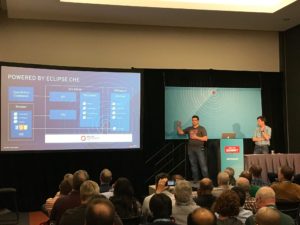
Part II of the OpenShift.io Developer Tools overview follows on the heels of the introduction session, this time presented by Pete Muir and Gorkem Ercan. In this session, we are taken through the integrated OpenShift.io Eclipse Che IDE.
What is a Cloud Workspace?
One of the fundamental problems with today's development methodology is that development happens on your laptop-- in a completely different environment from production. This is one of the major sources of bugs as your software is migrated through the release pipeline. To help address this issue, OpenShift.io includes the full Eclipse Che IDE. Development actually happens in an environment exactly matching production. This includes integrated compilers, build agents, diagnostics, context analysis, debuggers and test runners.
Each Cloud Workspace is its own container, completely isolated from your operating system and even your laptop. Moreover, a Cloud Workspace is assigned a unique ID and URL, which can be shared with others (think Google Docs). In fact, the IDE session is exactly preserved, down to attached debuggers and even cursor location. You can easily switch between workspace sessions by URL. Being able to rapidly switch between different code repos as life happens is tremendously useful.
Speaking of code repos, a Cloud Workspace includes an SCM in the form of Git. Currently, OpenShift.io includes GitHub integration. OpenShift.io prompts you to grant GitHub access to your repos for this native integration. Other Git providers are currently being developed as well.
Eclipse Che is Eclipse after all...
As you would expect with Eclipse or really and IDE, Eclipse Che gives you the standard development and testing experience. It is amazing that the full experience now runs in a browser with your code being executed in a container on OpenShift. If you want to pull up a terminal and execute maven directly, that is also an option.
Behind the screen, OpenShift runs Che pods (collections of containers) backed by persistent storage within the service. OpenShift routes are automatically created to allow your workspace to access whatever ports your application may require. This gives you all the benefits of testing within the cloud, in an environment matching your production environment.
If you have not had a chance to check out Eclipse Che, it is well worth a look. The integration with OpenShift.io brings the concept to an entirely new level, realizing the vision of a fully integrated development experience.
Head over to openshift.io to start trying these and many more features today!
Last updated: October 31, 2023
